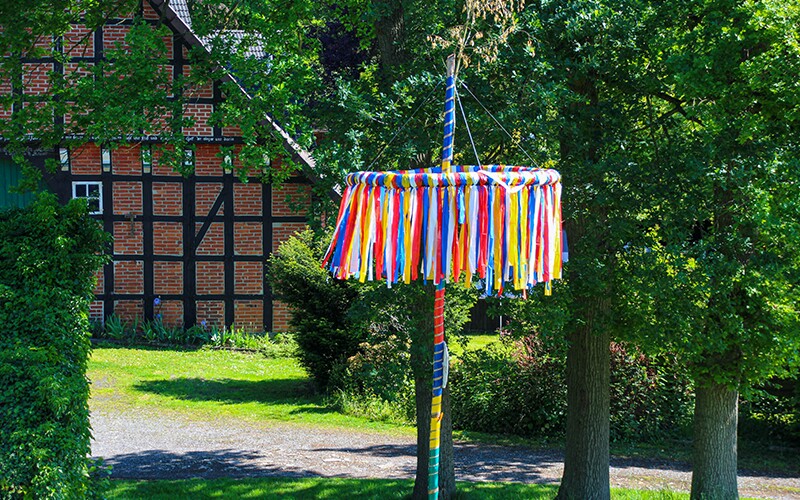Holiday celebrations are enjoyed all around the world. Some holidays are shared by many nations and peoples like the New Year, Christmas, and Easter, but some are unique to specific places. Here are a few German holidays and traditions!
Five Uniquely German Holidays
Have you heard of Walpurgis Night? How about Martinstag? Here is a list of 5 uniquely German holidays you will enjoy learning about.
Witches Night (Walpurgis Night)
Witches Night, or Walpurgis Night, is celebrated the night between April 30 and May 1. Families enjoy lighting bonfires and spending the evening outside. Sometimes, young people will play pranks and tricks similar to what is done on Halloween.

May Day (der Erste Mai)
This special spring holiday is held on May 1. It is sometimes linked to International Workers’ Day with rallies or protests. Maypoles and dancing are 2 of the lively traditions to expect on May Day in Germany. Most schools and businesses are closed for the day, allowing everyone to enjoy the day.
Oktoberfest
Oktoberfest is known throughout the world and includes lots of delicious German food. In Germany, Oktoberfest began on October 12, 1810, as a royal marriage celebration for King Louis I and Princess Therese von Sachsen-Hildburghausen. Oktoberfest begins in September and lasts for 2 weeks, ending on the first Sunday of October.
German Unity Day (Tag der Deutschen Einheit)
German Unity Day is a holiday that celebrates German reunification when the Berlin Wall fell in 1990. This special day is celebrated each year on October 3. Music, speeches, food, and fireworks are just a few of the noteworthy traditions of this uniquely German holiday.

St. Nicholas Day (Nikolaustag)
Little children all across Germany delight in St. Nicholas Day on December 6. On the night of December 5, children put a pair of shoes outside, and in the morning, the shoes are filled with candy and small gifts from St. Nicholas. In southern Germany, the gift giver is Baby Jesus or an angel. Some family traditions include a person dressed up as St. Nicholas and delivering the children’s treats, but only after they recite a Christmas poem or something of the sort!
Holiday Traditions in German
Germany is filled with old traditions, too. Traditions might be celebrated within a family, community, or other large groups. Many traditions are memorable events for families across the world. Here are a few delightful and frightful German traditions!
Legend of Knecht Ruprecht
Knecht Ruprecht is the patron saint of children in Catholicism. Some people believe that Knecht Ruprecht is the brother, ancestor, or assistant of St. Nicholas. Stories say that he was meant to keep naughty children in line. Knecht Ruprecht comes with Saint Nicholas on the night of December 5 and leaves a present in the children’s shoes according to their behavior. Good behavior gets a present and bad behavior will earn you a rod.
Various traditions describe Knecht Ruprecht as dressed in a dark robe, wearing bells, or accompanied by fairies. He is also known as Krampus in southern parts of Germany, a mythical creature that is half-goat and half-demon. The word krampen means “to claw” in German, so it doesn’t sound like a word usually associated with a holly jolly Santa Claus who likes milk and cookies!

Christmas Markets
German Christmas markets are scented with the smells of delicious foods and spices, and the air rings with the sound of Christmas carols. Many little shops are filled with handmade items like hand-carved ornaments for Christmas gift-giving. Though the Christmas market tradition began in Germany, other European countries enjoy the same holiday festivity.
Birthday Celebrations
German birthday celebrations for children are an all-day event. In some areas of Germany, the day starts with lighting a candle for each year of their life with one special candle representing the “light of life.” Those candles are blown out before cake is served and the child can secretly make a wish.
Other areas have candles to be blown out on the birthday cake, with the number of candles equal to the age of the child. Some families deliver a birthday cake to the child’s bed, let the birthday boy or girl pick the evening meal, and give gifts.

Hanging Lost Items in Trees
When people find a lost item like a mitten or scarf, they will hang it in a nearby tree. This helps the owner more easily find the lost item.
Record Your Holiday Stories
What are some of your most treasured family traditions and stories? You can write them down and share pictures for the whole family to view at FamilySearch Memories. Whether you have German ancestors or not, FamilySearch Memories is a place for everyone—and it’s free!
If you need a little help searching out your German ancestry, take a look at this helpful page from FamilySearch. It includes indexed German records, learning sessions especially for German research, and more.
Learn More about Germany
At FamilySearch, we care about connecting you with your family, and we provide fun discovery experiences and family history services for free. Why? Because we cherish families and believe that connecting generations can improve our lives now and forever. We are a nonprofit organization sponsored by The Church of Jesus Christ of Latter-day Saints. To learn more about our beliefs, click here.




